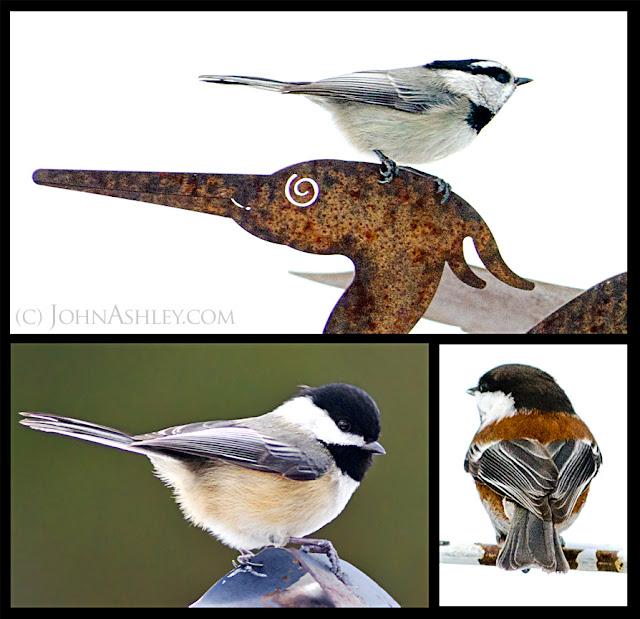 |
| Clockwise from bottom left: Black-capped, Mountain and Chestnut-backed Chickadees |
The familiar Black-capped Chickadee (Poecile atricapillus) ranges all across Montana (and the northern U.S. and southern Canada). In our forested neighborhood, however, the Mountain Chickadee (P. gambeli) is much more common, though it has a smaller range that includes western and central Montana (and inland portions of western states and provinces). Both of these species are smaller than the next two.
The handsome Chestnut-backed Chickadee (P. rufescens) rarely passes through our neighborhood, though I see them with some regularity up in Glacier Park. They range mostly along the west coast, with a disjunct population in northern Idaho and northwestern Montana. Boreal Chickadees (P. hudsonicus) are Canadian birds that barely range down into northwestern Montana, where they are listed as a "Species of Concern."
The original Chickadee plumage plan seems to belong to the Black-capped. It wears a black bib and cap over a white cheek, a gray back and pale-brown belly, and gray wings. The other three species appear as variations on this plan. The Mountain version is the only Chickadee that wears a striking, white eyebrow. My personal favorite, the Chestnut-backed, enhances the base plan with a rufous back, flanks and rump. The seldom-seen Boreal has a mix of these plumages. It features a brown cap, grayish back, and rufous sides.
A flock of Chickadees is known as a "banditry."
Behind the lens: If you pay for quality camera lenses, you don't want to put cheap UV filters on front for protection. Theses three images were made with the equivalent to cheap filters - I photographed the birds through the tinted windows in our house. The windows have a nearly-invisible plastic UV layer between the two glass panes, and it does fuzzy things to photographs. I was aware of the issue, and I could have cracked the sliding glass door open (the Chickadees wouldn't care), except that we have a 7-month-old puppy that would have tried to bolt out the door as long as it was open. Thus, fuzzy photos. Don't shoot through glass if at all possible, and don't use cheap filters on your lenses.

